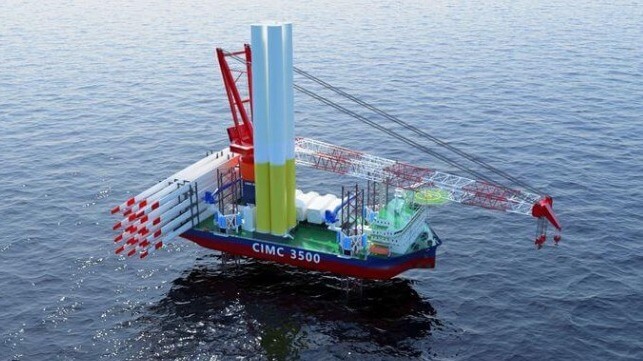Chinese Receive ABS AiP for Large WTIV with Dual-Fuel Methanol Power

A new generation of larger and more capable wind turbine installation vessels is planned to meet the challenges as the industry expands. China’s Yantai CIMC Raffles Offshore has been awarded approval in principle (AIP) for the designs of a dual-fuel methanol, heavy-duty, offshore wind turbine installation vessel (WTIV).
“This is an exciting development for the offshore wind market, which is a key player in the global energy evolution,” said Rob Langford, ABS Vice President, Global Offshore Wind. “Support vessels like WTIVs are in short supply, and new builds are being hampered by challenging market dynamics. This design from Yantai promises to meet the need for high-capacity, heavy-duty offshore wind projects.”
CIMC’s design calls for a WTIV capable of transporting and installing the largest wind turbines in the world. China is pushing the envelope with Mingyang Wind Power surprising the industry last fall by announcing it would have a 22 MW turbine completed by 2024 or 2025. Responding to the anticipated growth, CIMC expects growing demand to install wind turbines capable of producing 16 to 20 megawatts of electricity.
At the end of 2023, they reported that the massive Bo Qiang 3060, one of the largest and most capable vessels of its kind, was on sea trials. They highlighted that with upgrades the vessel would be able to handle turbines up to 20 MW.
In the latest designs, CIMC is now adding a dual-fuel methanol propulsion system. The design also features a 3,500-ton leg encircling crane and a strong, sea-keeping dynamic positioning system (DPS) that aligns with ABS class requirements DPS-2.
“The vessel is designed for the European market, with a maximum lifting weight of 3,500 tons and a maximum lifting height of 228 meters above sea level, and can carry seven sets of 14 MW or four sets of 20 MW wind turbine components. This vessel is equipped with a dual-fuel main engine and hybrid battery system, reducing carbon emissions and fuel consumption,” said Fu Qiang, Director of CIMC Raffles Strategy R&D Centre. “Given the complex international market and rising raw material prices, the design offers better economics and stronger competitiveness,” he predicts.
“ABS understands and is deeply involved in supporting clients with alternative fuels as part of their decarbonization journey. Methanol has emerged as a favorite among new designs as it represents a ‘here-now’ technology rather than a ‘hoped-for’,” said Panos Koutsourakis, ABS Vice President of Global Sustainability.
ABS highlights that it developed global standards for offshore wind foundations, both fixed and floating, substations and the unique vessels that support the industry. It certified the first semisubmersible offshore wind turbine WindFloat I, classed the world's largest floating wind turbine Windfloat Atlantic, and classed Kincardine, the world’s largest floating offshore windfarm at its commercial online date (COD). With more than 70 years of experience in the offshore sector, ABS says it understands the needs of owners and operators to enhance operational efficiencies with sustainable energy solutions.
Yantai CIMC Raffles Offshore will be competing against several Europeans that are also moving quickly to develop this new generation of larger and more capable installation vessels.
